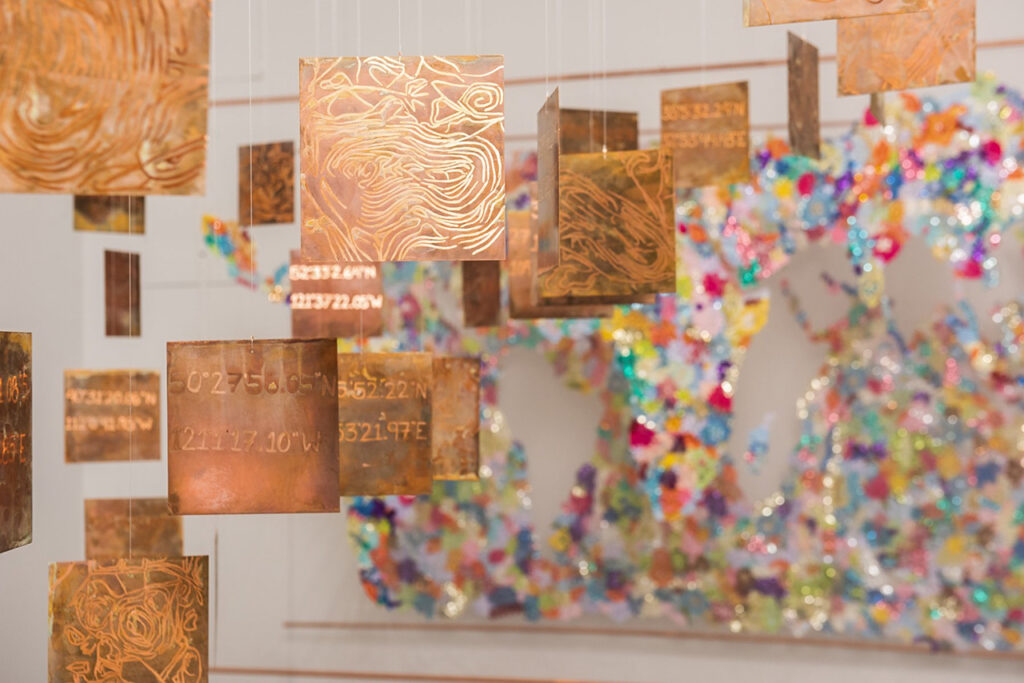
FOR IMMEDIATE RELEASE: Dec. 7, 2023
MEDIA CONTACT: Brian Passey | [email protected] | 480-874-4626
Carolina Aranibar-Fernández exhibition at SMoCA will examine the exploitation of natural resources

SCOTTSDALE, Ariz. — Including new large-scale installation works by San Francisco-based, Bolivian-born artist Carolina Aranibar-Fernández “Oleaje” will open Saturday, Feb. 10, at Scottsdale Museum of Contemporary Art (SMoCA).
“Oleaje,” Spanish for “Groundswell,” accentuates the hidden ripples of a global mining and trade industry that relies on forced access to natural resources and the human labor supplied by marginalized communities. Through extensive archival research and the use of labor-intensive handmaking processes — like etching, sewing, cutting and printing — Aranibar-Fernández translates the complex movements of resources on a global scale into vibrant, finely rendered impressions of cartography and topography.
“The worldwide exploitation of natural resources is a substantial issue,” Aranibar-Fernández said. “It’s clear that natural resources, like minerals and oil, have historically fueled and continue to feed colonization, imperialism and displacement. Growing up near regions abundant in natural resources, I became aware that these resources were frequently privatized with corporations situated thousands of miles away claiming ‘ownership.’”
This observation led the artist to question how those companies could be considered the “owners” of resources from faraway lands, seemingly unrelated to them. With this question, she was inspired to create work that examines these conversations.
Raised between the Andean mountains and the Amazon jungle, Aranibar-Fernández’s artistic practice draws on her first-hand experience witnessing the devastation of her homeland’s natural environment by foreign corporations. Through each work, Aranibar-Fernández meticulously traces and memorializes the impacts of capital flows and the environmental scarification found at the intersections of extraction and exploitation, exchange and power.
“Oleaje” is part of the series PROJECT SPACE — a SMoCA initiative that supports emerging and established artists in expanding their practice. The exhibition is curated by Keshia Turley, assistant curator at SMoCA.
“Carolina’s work has a soft poetic sense that I find both beautiful and devastating, all at once,” Turley said. “In many ways, her work is matter-of-fact in laying out years of meticulous research, but her delivery gives pause, particularly when you consider the laborious nature of her practice.”
Turley added that Aranibar-Fernández’s work speaks from personal experience, from the experience of those whose stories she has listened to and tried to tell, and from years of connecting dots. It has the quality of being able to draw in viewers from a glance and leave them lingering over layers of complexity.
A deliberate tension is created in Aranibar-Fernández’s work through her blend of the frangible — sequins, beads, plants and embroidery — with the material history of human consumption as a means of unveiling how extractive economies accelerate issues of global trade. “Oleaje” centers material as an active component in narrative-building, highlighting its continuous effect on ever-shifting geopolitical tensions and its intersectional role toward a remedial future.
Blood, soil and copper are all among the materials used in Aranibar-Fernández’s work. She works with these materials because, for her, it is an important way of listening.
“I come with an idea, but I continue to develop the work in conversation with the materials,” she said. “We often become disconnected from everything, imagining that we own ‘things’ and that we are more important than a mineral. But we are part of everything: if we hurt the soil, we are hurting ourselves. I am interested in allowing the materials to tell their part of the story.”
Though “Oleaje” officially opens to the public on Feb. 10, those who attend SMoCA’s 25th Birthday Celebration on Friday, Feb. 9, will be able to view the exhibition early. That event will feature a performance by Aranibar-Fernández alongside live music, food and drink, and more. Tickets will go on sale soon at SMoCA.org/events.
SMoCA — named “Best Art Museum” by the Phoenix New Times in the 2023 Best of Phoenix awards — is located at 7374 E. Second St., Scottsdale, Arizona 85251. It is open Wednesdays, Fridays, Saturdays and Sundays, 11 a.m. to 5 p.m., and on Thursdays, 11 a.m. to 7 p.m. Visit SMoCA.org for information.
Admission is $10–$12 for non-members; $7–$9 for students, seniors (65+) and veterans; and free for Scottsdale Arts ONE Members, healthcare workers, first responders, and patrons 18 and younger. Admission to the museum is pay-what-you-wish every Thursday and every second Saturday of the month. Save time and money by booking online at SMoCA.org.
Generous support for “Carolina Aranibar-Fernández: Oleaje” was provided by the Walter and Karla Goldschmidt Foundation.

